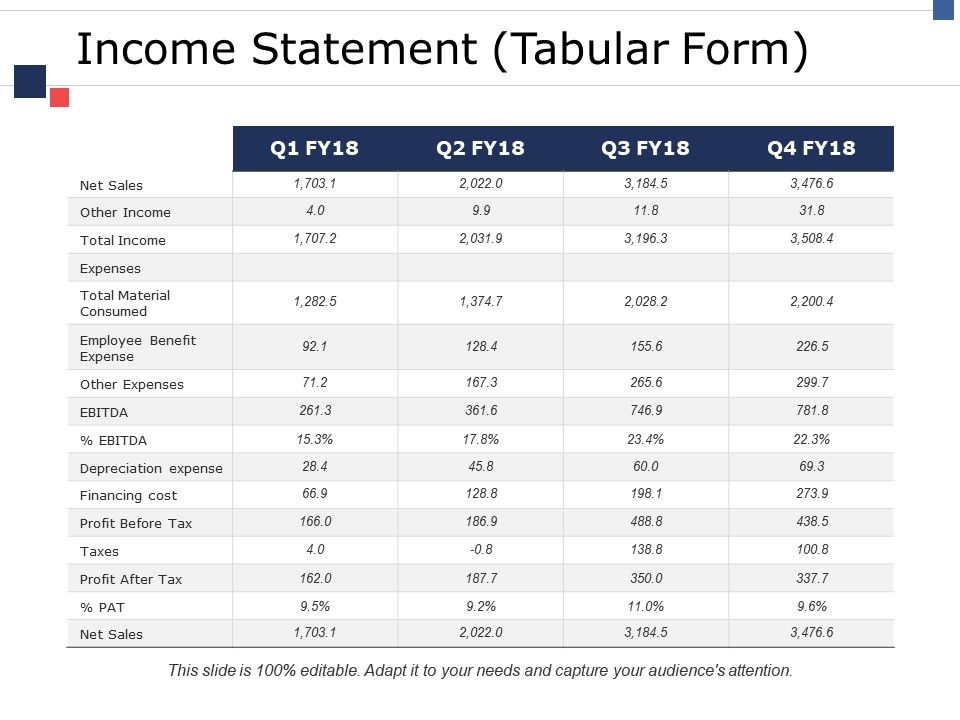


When the user explicitly resizes columns, the columns' preferred widths are set such that the user-specified sizes become the columns' new current widths. For an example of setting cell widths based on an approximation of the space needed to draw the cells' contents, see the initColumnSizes method in TableColumn supplies getter and setter methods for the minimum, preferred, and maximum widths of a column, as well as a method for getting the current width.
#Tabular form code
For example, adding the following code to SimpleTableDemo makes its third column bigger than the other columns:Ĭolumn = table.getColumnModel().getColumn(i) ĬtPreferredWidth(100) //third column is biggerĪs the preceding code shows, each column in a table is represented by a This sets both the preferred widths of the columns and their approximate relative widths. To customize initial column widths, you can invoke setPreferredWidth on each of your table's columns. By default, the table's size remains the same, and all columns to the right of the drag point resize to accommodate space added to or removed from the column to the left of the drag point. When the user resizes a column by dragging its right border, then either other columns must change size, or the table's size must change. When the table becomes wider or narrower (which might happen when the user resizes the window containing the table), all the column widths change appropriately. Here is typical code for creating a scroll pane that serves as a container for a table:Ĭontainer.add(table.getTableHeader(), BorderLayout.PAGE_START) Ĭontainer.add(table, BorderLayout.CENTER) īy default, all columns in a table start out with equal width, and the columns automatically fill the entire width of the table. If you want to get around these restrictions, you need to implement your own table model, as described in Creating a Table Model. For example, if you are instantiating a set of objects from a database, you might want to query the objects directly for their values, rather than copying all their values into an array or vector. They require that you put all of the table's data in an array or vector, which may not be appropriate for some data.You can see this difference in the Vegetarian column of the previous figure. However, if you use either of the two JTable constructors listed previously, your Boolean data is displayed as a string. For example, if a table column has Boolean data, the table can display the data in a check box. They treat all data types the same (as strings).They automatically make every cell editable.However, these constructors also have disadvantages: The advantage of these constructors is that they are easy to use. JTable(Vector rowData, Vector columnNames).

JTable(Object rowData, Object columnNames).There are two JTable constructors that directly accept data ( SimpleTableDemo uses the first): JTable table = new JTable(data, columnNames) SimpleTableDemo.java declares the column names in a String array: Resize the window containing the table so that it's bigger than necessary to display the whole table.Īll the table cells become wider, expanding to fill the extra horizontal space.The column changes size, and the other columns adjust to fill the remaining space. Now press the mouse button and drag to the right or left. Position the cursor just to the right of a column header. Now press the mouse button and drag to the right.Īs you can see, users can rearrange columns in tables. Generally, you begin editing a text cell by double-clicking it. A special highlight indicates that the "Snowboarding" cell is editable. The entire first row is selected, indicating that you have selected Kathy Smith's data. Or, to compile and run the example yourself, consult the example index.Ĭlick the cell that contains "Snowboarding".
#Tabular form download
Java™ Web Start ( download JDK 7 or later). Click the Launch button to run SimpleTableDemo using


 0 kommentar(er)
0 kommentar(er)
